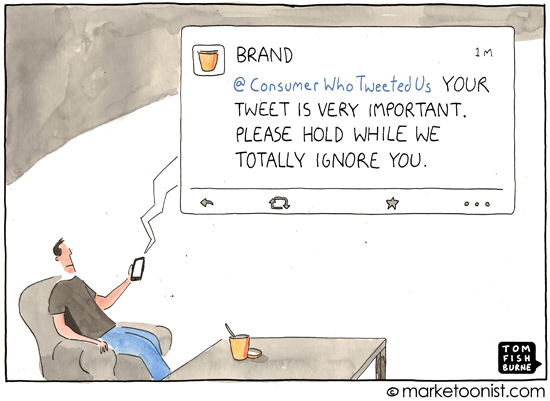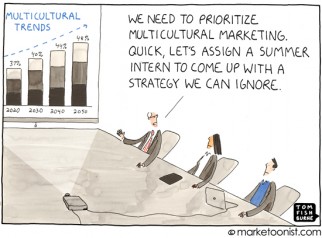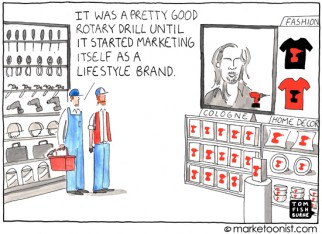Many brands are hardwired for one-way conversations. These brands work hard to limit the time actually engaging with consumers. They consider call centers as cost centers. They sometimes program the call center computer voice to say that “0” is not a valid option because they don’t want to pay for anyone to talk to a live person.
These brands may give lip service to two-way conversations, but its superficial. They use social media as a megaphone. They may search for positive comments about the brand to retweet, but they don’t actually solve anyone’s problems.
I was pleasantly surprised recently with a conversation I had with United Airlines over Twitter. I was scheduled to fly from SFO the day of the Asiana tragedy, which messed up flights for a week. I ultimately drove the 6 hours to LAX to fly from there, but I couldn’t get through to United by call center. I was on hold for over two hours, and finally lost the call driving to LA.
Out of desperation, I tweeted @United. I didn’t hold much hope because I’ve had rotten service experiences with United (several bad enough to inspire three different cartoons). But to my surprise, @United not only replied relatively quickly, they were able to change my flights through a series of DM messages, 140 characters at a time.
Any brand can outsource social media to have superficial conversations. What is impressive are brands that can use social media to actually solve their customers’ problems. If only United could adopt this mindset in other areas of their organization, but it’s a start.
I’d love to hear your thoughts on brands that excel at the two-way conversation.
(Marketoonist Monday: I’m giving away a signed print of this week’s cartoon. Just share an insightful comment to this week’s post by 5:00 PST on Monday. Thanks!)



Ori Pomerantz says
From the management perspective, it is a lot easier to treat marketing as a separate silo from operations. Unfortunately, the world is full of managers who think “easy for management” is the purpose of running a business.
Julio Tavarez says
I am just amazed that you continue to fly with United after you have gone through with them. I guess thats a testament to their loyalty program.
Bill Carlson says
I am a little torn on this topic…
On the one hand, there can never be enough customer service, every customer/prospect engagement should be treasured and maximized, etc., etc.
And I think this is more true of services than products — not to diminish the value of customer service to products but services by definition imply the brand-customer interaction and that should always(!) be a positive.
On the other hand, ROI. Clearly a marketing benefit to be able to point to customer satisfaction surveys, and one could argue that an investment in an above-average customer service function is in fact a marketing investment (I have made such arguments myself!). But at some point, based on demand, market pricing, competitors and other factors, a brand can only afford so much customer service.
And that practical reality tends to get lost in a philosophical discussion like this.
I actually think if it comes down to social media being a channel for resolving customer issues (note: talking here about a brand resolving immediate issues like re-booking a flight, not about feedback and other interactions), then something is wrong with the brand’s overall customer service/interaction efforts.
In your example, an inability to quickly connect with United’s call center was probably to be expected as that event (which can never be predicted and adequately planned for… happily, I suppose?) triggered the usual domino effect in air travel. I liken this to a city’s ability to clear snow after a major snowfall — if we citizens are willing to pay higher taxes, the local governments could have twice as many plows and people ready 24/7 all winter long “just in case”. But we would object to those taxes, no? And we can (but most won’t) pay 10% (as an example) more to fly an airline based on “just in case I need it” customer service.
So… being realistic, it’s clearly a balancing act. And responding to issues at the individual consumer level raised on social media is probably more a testament to the potential negative reaction that would multiply there by *not* responding.
Net net — social media may be a fine tool for staying in touch with customers, worthy of supporting as a tactic for input/discussion about all aspects of products/services, but it should not be a tactic for direct problem-solving by the brand. Personally, I think it would have been better for United to initiate a call to you from the call center or provide you a direct-access phone number to bring the management of your issues back into the overall customer service system.
Credit them for their responsiveness for sure, and again, I support the value of quality customer service, but not so sure I think social media is the right way to get there…
Loring Allen says
I agree with the last paragraph of Bill’s comment above. If only a tweet could result in a direct call to you by someone higher up the chain that might make it better, especially when things are not getting resolution through regular channels.
I recently tweeted a couple of exasperated comments directed at a particular phone carrier to which they replied, “follow us and we’ll direct tweet with you to resolve the problem.” If I hadn’t already spent close to 12 hours of my life “on hold and talking through the problem with each of 7 customer service reps over the course of 3 weeks then I may have been a bit more receptive to explaining in 140 characters at a time, my problem. As Bill said, tweet me a better phone number to call (one linked to the manager of the call center / customer service people I was dealing with), or better yet ask me for my number and call me.
In the end it took a direct conversation with a person in the actual department where my problem was originating from to resolve it. I now have her phone number, and her work schedule for future reference. She was great. But I only got to her after I was practically begging to talk with a manager (no luck, always in a meeting!) and even suggested that they have a person with the expertise in my phone’s problem area give me a call.
So there is a role for Twitter, just not for solving problems.
Ori Pomerantz says
Bill: On the other hand, ROI. Clearly a marketing benefit to be able to point to customer satisfaction surveys, and one could argue that an investment in an above-average customer service function is in fact a marketing investment (I have made such arguments myself!). But at some point, based on demand, market pricing, competitors and other factors, a brand can only afford so much customer service.
Ori: True, but this is where social media really shines. You can distinguish between the unimportant Tony Ten-Followers and the crucial Mildred Nearly-a-Million-Followers and focus your great service on the second.
Ted Simon says
I see value in what Loring and Bill have said. The fact that United provided shoddy customer service in not dealing well with the issue at hand via phone call is the only reason Tom was forced to tweet them. I agree that direct call support is a better, preferred and maybe more reassuring option for these kinds of matters.
However, I would not go so far as to say that the social channel is “not for solving problems.” It may not be the FIRST option of choice in a matter like this, but without this option Tom might never have gotten off the ground in LA. And, there might be situations where some quick digital back and forth is a viable option for addressing an issue, problem or situation.
I also find it interesting that the long-standing, well-established customer service channel failed Tom, yet the new channel (Twitter) yielded very fast results. Makes me wonder if the cultural differences in these communication technologies underlies this issue. Call centers are notoriously slow and are being squeezed to keep costs down (which makes them slow and unresponsive — vicious cycle), whereas the social world is based on fast recognition and response. Not making a statement of fact, just something to factor into the discussion.
In the end I agree with Tom’s point: it IS impressive when brands are so responsive in dealing with customers and solving problems. It makes it all the more ironic, and sad, when the rest of the organization cannot/does not adopt that same customer-centric attitude.
Andrew says
I wouldn’t say they excel, but I had a similar experience to yours with Delta. After terrible customer service by the actual humans on the ground when storms cancelled a flight and 14+ hours waiting for the traditional customer service line to respond (estimated call-back time: 90 minutes…), I managed to resolve the problem through Twitter in “only” 90 minutes.
On the other hand, the MN Twins apparently don’t monitor their customer service Twitter feed — I never received a response after a series of messages to them.
It seems to be the small, local places that really deliver on that front in my experience. Whether it’s restaurants, stores, food trucks, etc., a lot of them have regularly gone above and beyond any expectation I ever could have had. I think it’s often a question of scale.
tomfishburne says
Hi all,
Really great insight, many thanks! United is a funny case study, because I certainly wouldn’t remain a customer if I had a choice. Living in San Francisco and prioritizing direct flights means that I’m wedded to United, for better for for worse.
This week’s cartoon goes to Ted Simon. It will be interesting to see if the customer focus on Twitter will extend elsewhere in the organization.
Thanks!
-Tom
Ted Simon says
Many thanks, Tom. I’m flattered…and look forward to my very own “Fishburne.” 🙂
Keep up the great work. Your creativity and insights are a highlight of my Mondays.
– Ted
chris says
I follow several DJs on Twitter. Some retweet nice things you say, that always feels fake. Some Actually respond by saying thank you or whatever. That feels so much nicer, I guess its more effort for them & im aware that most responses wont be the actual artist but for me, that doesnt make a difference: having a personal response to a personal but public message is really cool. It’s something I try to be aware of when setting up business-to-customer communication like this.